Fasteners are used in automobiles, industries, furniture, tools, residential and many other applications to make a joint between two objects (metal, wood, plastic etc.) and hold them together. Fasteners such as nuts, screws and bolts etc. can be used to easily installed or removed due to their threaded structure. There are different types and sizes of Bolts and to understand them better, we will see a Bolt Size Chart which describes all the important dimensions of a Bolt.
Before looking at the Bolt Size Chart, we will first try to learn about Bolts in general, some important identifications associated with Bolts, the method of measuring the Bolt’s Size and many other things.
Outline
ToggleIntroduction To Bolts, Nuts and Washers
A Bolt is a cylindrical object with a hexagonal (sometimes square) head on one end and threads (fully or partially) on the other end. A Nut is the counterpart of the Bolt and it is hexagonal (sometimes square) object with threads on the inside. The pitch of the threads on the bolt and nut should be the same for securing them properly.
Another important object is the washer. It is used to increase the contact area between the nut and the surface, which in turn reduces the stress of the surface. It also protects the surface from damage due to tightening of the nut.
The combination of a bolt, a nut and a washer can be used to secure two objects and the best part is the joint is temporary in the sense you can remove it anytime just by loosening the nut.
If two parts must be joined together, then the first step is to drill a hole in the objects. The hole can be tapped or normal. If the hole is a tapped hole, then the bolt can be simply threaded into the hole (provided the pitch of the hole and the bolt is the same) without the need for a nut to secure the bolt. If it is a normal hole, then you have to use a washer and nut to properly secure the bolt.
An important point about the dimension of the hole to be drilled is it must of the same diameter as the diameter of the bolt or slightly larger than that.
Different Bolt Materials
The material used in the manufacturing of the bolts will determine its strength, applications, corrosion resistance etc. There are several materials of Bolts and some of the popular ones are:
- Zinc-Plated Steel: It is one of the popular and commonly used bolt materials for general purpose applications, usually indoor. Depending on the type of manufacturing, the color of the bolt may be bluish or yellowish tint. It is a low carbon steel with a Zinc coating that provides moderate corrosion resistance. They are very cheap to manufacture as well.
- Stainless Steel: One of the toughest bolt materials with very good corrosion resistance. As a result, stainless steel bolts are often used in industries, automobiles, ships (and other marine equipment) and outdoor objects in general. They are slightly expensive than the Zinc plated counterparts.
- Chrome / Nickel Plated Steel: Although stainless steel already consists of chromium, additional Chrome and Nickel plating of steel further increases the corrosion resistance. The other benefit of this plating is the surface of the bolt looks very shiny, smooth and polished.
- Hot-dipped Galvanized Steel: In this type, the steel is coated with even thicker layer of Zinc for increased corrosion resistance and thus making them suitable for outdoor use. Even the nuts and washers must be of the galvanized type for proper coupling.
- Brass / Bronze: These types of bolts have a natural resistance to corrosion as they are alloys of copper. They are generally expensive than other bolt materials and as a result they are often used in arts and decorative pieces.
- Alloy Steel: The Alloy Steel contains additional elements other than iron and carbon such as manganese, nickel, chromium etc. The result is a bolt with very good strength, corrosion resistance and wear resistance. It is often black in color due to additional black oxide coating.
Common Types of Bolts
As Bolts and Nuts are one of the commonly used fasteners, there are different types of bolts for different types of applications. Some of the more common and popular types of bolts are:
- Hex Bolt
- Lag Bolt
- J-Bolt
- U-Bolt
- T-Bolt
- Anchor Bolt
- Carriage Bolt
- Flange Bolt
- Eye Bolt
- Elevator Bolt
- Plow Bolt
- Hanger Bolt
- Timber Bolt
- Shoulder Bolt
- Stud Bolt
- Toggle Bolt
Bolt Dimensions Chart
Before looking at the Bolt Size Chart, let us first try to understand different proportions and dimensions associated with a bolt. The following image shows a typical hex bolt with all the important dimensions marked on it.
A bolt can be divided into two parts: Bolt Head and Bolt Body
Bolt Head
The head of the bolt is usually hexagonal shape (sometimes square or circular) and is used to tighten or loosen the bolt. The size of the head is dependent on the shank’s nominal diameter.
Bolt head can have three important dimensions. They are:
- Size across the Flats
- Size across corners
- Height of the Head
Bolt Body
The Bolt Body consists of the main shank with full or partial threads. Bolt Body can have important dimensions. They are:
- Bolt Diameter
- Body Length
- Thread Length
- Thread Pitch
The diameter of the Bolt is the actual size of the bolt and it is measured across the bolt shank or the threaded area. The body length of the bolt is measured from the tip of the bolt to the point where the shank meets the head. If the bolt is partially threaded, then the thread length can also be measured.
Thread Pitch is an important dimension associated with a Bolt. In imperial system, the thread pitch of the bolt is determined by the number of threads in one inch. In metric system, the distance between two adjacent threads in millimeters is considered as the Thread Pitch.
The thread pitch can be further categorized into coarse (or standard), fine and super fine (or extra fine) threads. Coarse Threaded bolts have lower thread count than the other types are very common in general purpose applications. For precision applications and situation where you require more holding force, fine threaded bolts are used.
Grade or Class
Another important specification associated with bolts is its grade (imperial) or class (metric), which determines the tensile strength of the bolt. The tensile strength of a bolt is the maximum stress / stretch it can handle before it breaks.
In USCS imperial system, the bolt’s tensile strength is represented using ‘grade marks’ on the top of the head. The ‘grade marks’ are nothing but radial lines and more the number of lines on the head of the bolt, greater is the strength of the bolt.
In metric system, the strength of the bolt is determined using its class number, which is also printed on the head of the bolt. Higher the class number, greater is the strength of the bolt. If the number is followed by another number (for example, 10.9), then the second number represents the yield strength of the bolt, which determines the stress it can handle before it cannot return to its original shape without damage.
Consider a Class 10.9 Bolt. Here, this bolt has a tensile strength of 1,000MPa (145,000PSi) and a yield strength of 900MPa (130,000PSi).
Bolt Size Chart
Let us now see some bolt size charts. We will see both imperial and metric charts for bolt dimensions as well as the thread pitch.
Imperial Bolt Size Chart
|
Nominal Size |
Bolt Diameter ‘D’ | Across Flats ‘A’ | Across Corners ‘B’ | Head Height ‘C’ | Thread Length ‘L’ | Transition Length ‘Y’ | |||||||
| Max (in) | Min (in) | Nominal (in) | Max (in) | Min (in) | Max (in) | Min (in) | Nominal (in) | Max (in) | Min (in) | ≤6 in | >6 in |
Max (in) |
|
|
1/4 |
0.25 | 0.245 | 7/16 | 0.438 | 0.428 | 0.505 | 0.488 | 5/32 | 0.163 | 0.15 | 0.75 | 1 | 0.25 |
| 5/16 | 0.3125 | 0.3065 | 1/2 | 0.5 | 0.489 | 0.577 | 0.557 | 13/64 | 0.211 | 0.195 | 0.875 | 1.125 |
0.278 |
|
3/8 |
0.375 | 0.369 | 9/16 | 0.562 | 0.551 | 0.65 | 0.628 | 15/64 | 0.243 | 0.226 | 1 | 1.25 | 0.312 |
| 7/16 | 0.4375 | 0.4305 | 5/8 | 0.625 | 0.612 | 0.722 | 0.698 | 9/32 | 0.291 | 0.272 | 1.125 | 1.375 |
0.357 |
|
1/2 |
0.5 | 0.493 | 3/4 | 0.75 | 0.736 | 0.866 | 0.84 | 5/16 | 0.323 | 0.302 | 1.25 | 1.5 | 0.385 |
| 9/16 | 0.5625 | 0.5545 | 13/16 | 0.812 | 0.798 | 0.938 | 0.91 | 23/64 | 0.371 | 0.348 | 1.375 | 1.625 |
0.417 |
|
5/8 |
0.625 | 0.617 | 15/16 | 0.938 | 0.922 | 1.083 | 1.051 | 25/64 | 0.403 | 0.378 | 1.5 | 1.75 | 0.455 |
| 3/4 | 0.75 | 0.741 | 1-1/8 | 1.125 | 1.1 | 1.299 | 1.254 | 15/32 | 0.483 | 0.455 | 1.75 | 2 |
0.5 |
|
7/8 |
0.875 | 0.866 | 1-5/16 | 1.312 | 1.285 | 1.516 | 1.465 | 35/64 | 0.563 | 0.531 | 2 | 2.25 | 0.556 |
| 1 | 1 | 0.99 | 1-1/2 | 1.5 | 1.469 | 1.732 | 1.675 | 39/64 | 0.627 | 0.591 | 2.25 | 2.5 |
0.625 |
|
1-1/8 |
1.125 | 1.114 | 1-11/16 | 1.688 | 1.631 | 1.949 | 1.859 | 11/16 | 0.718 | 0.658 | 2.5 | 2.75 | 0.714 |
| 1-1/4 | 1.25 | 1.239 | 1-7/8 | 1.875 | 1.812 | 2.165 | 2.066 | 25/32 | 0.813 | 0.749 | 2.75 | 3 |
0.714 |
|
1-3/8 |
1.375 | 1.363 | 2-1/16 | 2.062 | 1.994 | 2.382 | 2.273 | 27/32 | 0.878 | 0.81 | 3 | 3.25 | 0.833 |
| 1-1/2 | 1.5 | 1.488 | 2-1/4 | 2.25 | 2.175 | 2.598 | 2.48 | 1-5/16 | 0.974 | 0.902 | 3.25 | 3.5 |
0.833 |
|
1-3/4 |
1.75 | 1.738 | 2-5/8 | 2.625 | 2.538 | 3.031 | 2.89 | 1-3/32 | 1.134 | 1.054 | 3.75 | 4 | 1 |
| 2 | 2 | 1.988 | 3 | 3 | 2.9 | 3.464 | 3.306 | 1-7/32 | 1.263 | 1.175 | 4.25 | 4.5 |
1.111 |
|
2-1/4 |
2.25 | 2.238 | 3-3/8 | 3.375 | 3.262 | 3.897 | 3.719 | 1-3/8 | 1.423 | 1.327 | 4.75 | 5 | 1.111 |
| 2-1/2 | 2.5 | 2.488 | 3-3/4 | 3.75 | 3.625 | 4.33 | 4.133 | 1-17/32 | 1.583 | 1.479 | 5.25 | 5.5 |
1.25 |
|
2-3/4 |
2.75 | 2.738 | 4-1/8 | 4.125 | 3.988 | 4.763 | 4.546 | 1-11/16 | 1.744 | 1.632 | 5.75 | 6 | 1.25 |
| 3 | 3 | 2.988 | 4-1/2 | 4.5 | 4.35 | 5.196 | 4.959 | 1-7/8 | 1.935 | 1.815 | 6.25 | 6.5 |
1.25 |
Thread Pitch
|
Bolt Size |
Thread Pitch |
|
|
(in) |
Coarse | Fine |
| 1/4 | 20 |
28 |
|
5/16 |
18 | 24 |
| 3/8 | 16 |
24 |
|
7/16 |
14 | 20 |
| 1/2 | 13 |
20 |
|
9/16 |
12 | 18 |
| 5/8 | 11 |
18 |
|
3/4 |
10 | 16 |
| 7/8 | 9 |
14 |
|
1 |
8 | 14 |
| 1-1/8 | 7 |
12 |
|
1-1/4 |
7 | 12 |
| 1-3/8 | 6 |
12 |
|
1-1/2 |
6 | 12 |
| 1-3/4 | 5 |
– |
|
2 |
4-1/2 | – |
| 2-1/2 | 4 |
– |
|
3 |
4 |
– |
Metric Bolt Size Chart
In metric system, the bolts (and nuts) are usually referred using the letter ‘M’ followed by additional dimensions. For example, a common metric specification of a bolt is “M6-1.0 x 20”. Here,
- ‘M’ indicates the bolt uses metric threads
- ‘6’ indicates the nominal diameter of the bolt (at the shank or the threads)
- ‘1.0’ indicates the thread pitch of the bolt in millimeter
- ‘20’ indicates length of the bolt in millimeter
|
Size |
Pitch | Across Flats ‘A’ | Across Corners ‘B’ | Head Height ‘C’ | Bolt Diameter ‘D’ | ||
| (mm) | Max (mm) | Min (mm) | Min (mm) | Max (mm) | Max (mm) |
Min (mm) |
|
|
M5 |
0.8 | 8 | 7.78 | 9.2 | 3.5 | 5 | 4.82 |
| M6 | 1 | 10 | 9.78 | 11.5 | 4 | 6 |
5.82 |
|
M8 |
1.25 | 13 | 12.73 | 15 | 5.3 | 8 | 7.78 |
| M10 | 1.5 | 16 | 15.73 | 18.4 | 6.4 | 10 |
9.78 |
|
M12 |
1.75 | 18 | 17.73 | 20.7 | 7.5 | 12 | 11.73 |
| M14 | 2 | 21 | 20.67 | 24.2 | 8.8 | 14 |
13.73 |
|
M16 |
2 | 24 | 23.67 | 27.7 | 10 | 16 | 15.73 |
| M18 | 2.5 | 27 | 26.67 | 31.2 | 11.5 | 18 |
17.73 |
|
M20 |
2.5 | 30 | 29.67 | 34.6 | 12.5 | 20 | 19.67 |
| M22 | 2.5 | 34 | 33.38 | 39.3 | 14 | 22 |
21.67 |
|
M24 |
3 | 36 | 35.38 | 41.6 | 15 | 24 | 23.67 |
| M27 | 3 | 41 | 40.38 | 47.3 | 16.7 | 27 |
26.67 |
|
M30 |
3.5 | 46 | 45 | 53.1 | 18.7 | 30 | 29.67 |
| M33 | 3.5 | 50 | 49 | 57.7 | 20.5 | 33 |
32.61 |
|
M36 |
4 | 55 | 53.8 | 63.5 | 22.5 | 36 |
35.61 |
Thread Pitch
|
Size |
Coarse (mm) | Fine (mm) | Super Fine (mm) |
| M2 | 0.4 | – |
– |
|
M2.5 |
0.45 | – | – |
| M3 | 0.5 | – |
– |
|
M3.5 |
0.6 | – | – |
| M4 | 0.7 | – |
– |
|
M5 |
0.8 | – | – |
| M6 | 1 | 0.75 |
– |
|
M7 |
1 | – | – |
| M8 | 1.25 | 1 |
– |
|
M10 |
1.5 | 1.25 | 1 |
| M12 | 1.75 | 1.5 |
1.25 |
|
M14 |
2 | 1.5 | – |
| M16 | 2 | 1.5 |
– |
|
M18 |
2.5 | 1.5 | – |
| M20 | 2.5 | 1.5 |
– |
|
M22 |
2.5 | 1.5 | – |
| M24 | 3 | 2 |
– |
|
M27 |
3 | 2 | – |
| M30 | 3.5 | 2 |
– |
|
M33 |
3.5 | 2 | – |
| M36 | 4 | 3 |
– |
|
M42 |
4.5 | 3 | – |
| M48 | 5 | 3 |
– |
|
M56 |
5.5 | 3 |
– |
How To Use Bolt Size Charts?
Bolt size charts might seem intimidating at first glance, but with a little understanding, they become your secret weapon for choosing the perfect bolt for any project. Here’s how to navigate them based on your needs:
How to Use Bolt Size Charts: Selecting the Right Bolt for Your Project
Bolt size charts might seem intimidating at first glance, but with a little understanding, they become your secret weapon for choosing the perfect bolt for any project. Here’s how to navigate them based on your needs:
1. Identify Your Project Requirements:
Before diving into the chart, gather some key information about your project:
- Material: What are you bolting together? Wood, metal, plastic? Different materials have different strength requirements, and the chart will consider this.
- Strength: How much weight or pressure will the bolt need to withstand? For non-critical applications, a standard bolt might suffice. But for heavy-duty projects, you’ll need a stronger bolt based on its rating.
- Thread Type and Length:
- Thread Type: Is a coarse thread (UNC) for wood or general applications, or a fine thread (UNF) for tighter connections in metal, suitable?
- Length: Measure the desired length of the bolt, considering the thickness of the materials you’re joining and how much thread engagement (screwed into the material) is needed for a secure hold.
2. Navigating the Chart:
With your project requirements in mind, locate a bolt size chart. These can be found online from various sources like manufacturer websites or hardware store resources.
Here’s a breakdown of a typical bolt size chart and how to use it based on your gathered information:
- Columns:
- Diameter: This column lists the nominal diameter of the bolt shaft in millimeters (mm) or inches (“).
- Thread Pitch: This column specifies the thread pitch, indicating the number of threads per inch (TPI) or millimeter (mm).
- Length: This column shows various lengths the bolt might be available in.
- Rows: These might be designated for different materials (wood, metal, etc.) or strength ratings.
3. Putting it All Together:
- Look for the row that corresponds to your project’s material (e.g., wood, metal).
- Within that row, identify the thread type (coarse or fine) that best suits your application.
- Now, consider the strength requirement. Some charts might have separate sections for different bolt strengths. Choose the appropriate section based on the load your bolt needs to handle.
- Finally, find the intersection of your chosen diameter, thread type (and strength section, if applicable), and desired length. This will indicate the specific bolt size you need for your project.
Example:
Let’s say you’re building a wooden bookshelf and need to connect two thick pieces of plywood. You want a general-purpose bolt with a good hold.
- Material: Wood
- Strength: Non-critical application (bookshelf)
- Thread Type: Coarse thread (UNC) for wood is suitable.
- Length: You measure the combined thickness of the plywood pieces to be 20mm, and you want some extra thread engagement for security, so you decide on a 30mm bolt length.
Following these steps on a bolt size chart, you might find that a M6 x 1.0 x 30mm bolt (metric thread, 6mm diameter, coarse 1.0mm pitch, 30mm length) would be a perfect choice for your project.
Note: If you’re unsure about any aspect of bolt selection, consult a professional at your local hardware store for guidance. They can help you ensure you choose the right bolt size and strength for a safe and successful project.
Conclusion
An introductory article on Bolts, common bolt materials, different types of bolts, typical specification and dimensions of Bolts. You also learn about Bolt Size, Bolt Head Size and their difference with the help of images and Bolt Size Chart. The Bolt Size Chart is given for both imperial as well as metric units for both bolt dimensions and thread pitch.

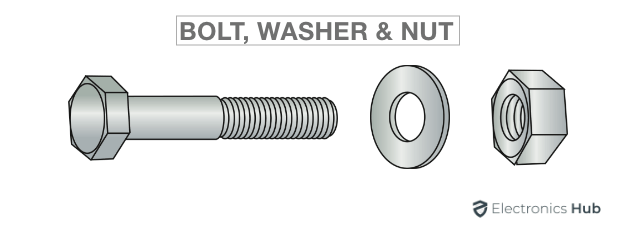
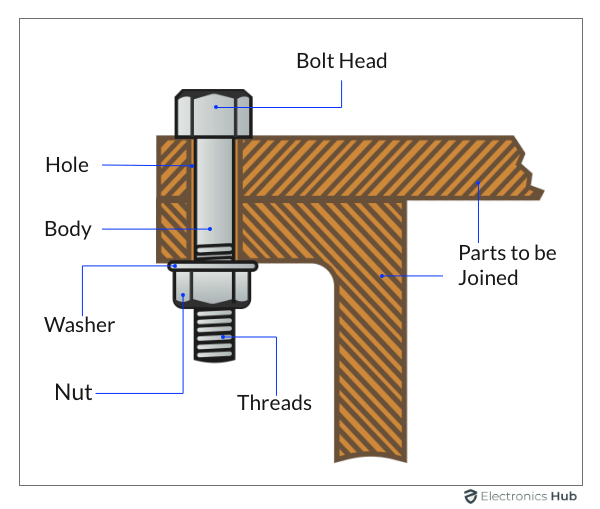
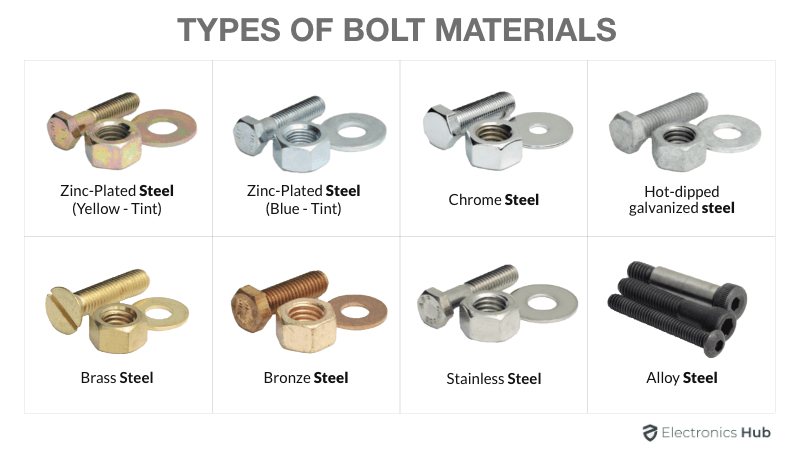
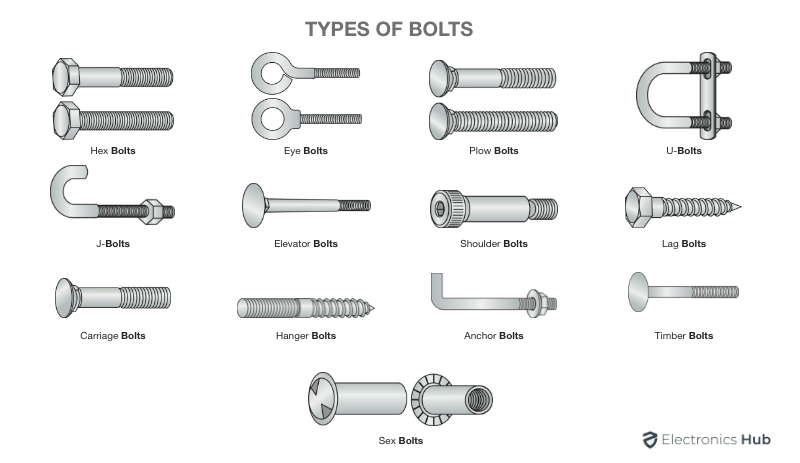
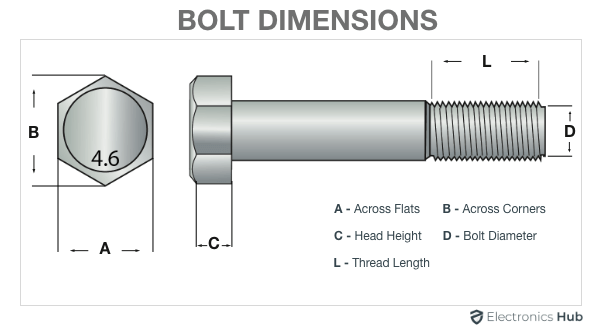
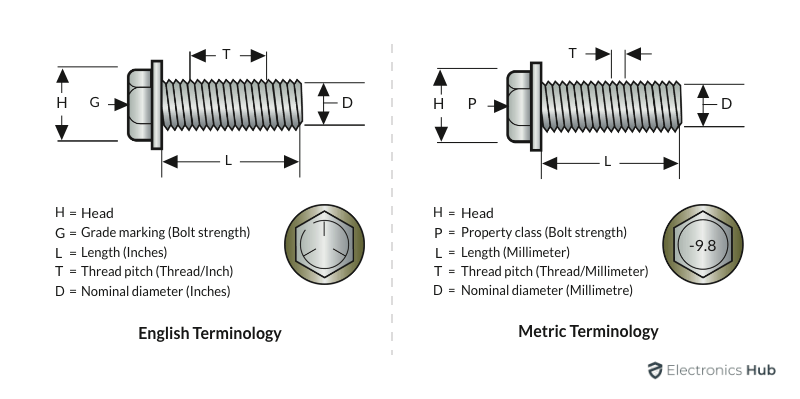
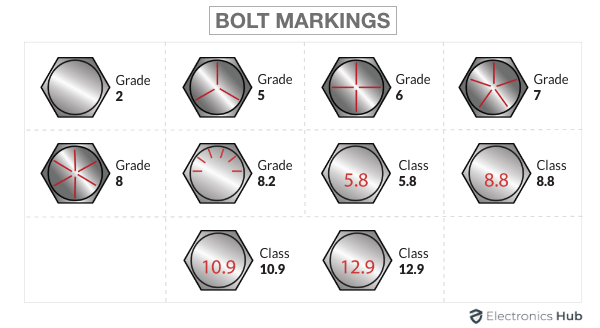

2 Responses
Excelent information
Thank you for the good information. What about bolts less than 1/4″?